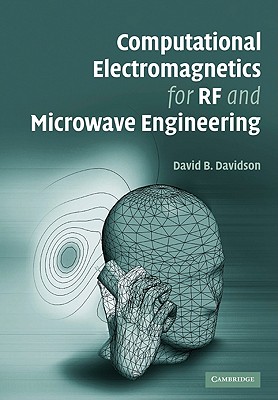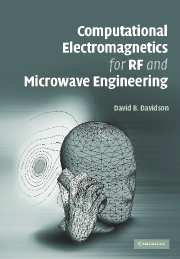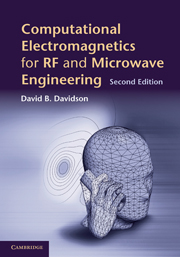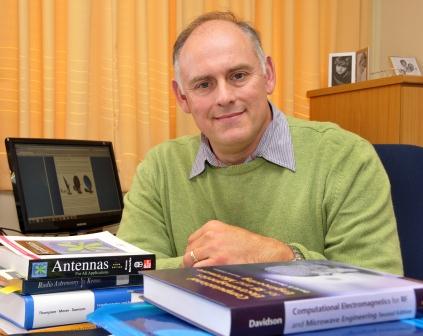Computational Electromagnetics for RF and Microwave Engineering
by David B. Davidson
------------------------------------------------------------------------------------
简介
The numerical approximation of Maxwell's equations, Computational Electromagnetics (CEM), has emerged as a crucial enabling technology for radio-frequency, microwave and wireless engineering. The three most popular 'full-wave' methods - the Finite Difference Time Domain Method, the Method of Moments, and the Finite Element Method - are introduced in this book by way of one or two-dimensional problems. Commercial or public domain codes implementing these methods are then applied to complex, real-world engineering problems, and a careful analysis of the reliability of the results obtained is performed, along with a discussion of the many pitfalls which can result in inaccurate and misleading solutions. The book will empower readers to become discerning users of CEM software, with an understanding of the underlying methods and confidence in the results obtained. It also introduces readers to the art of code development. This book is aimed at senior undergraduate/graduate students taking CEM courses and practising engineers in the industry.
------------------------------------------------------------------------------------
Preface page xiAcknowledgements xvTo the reader xviiList of notation xviii1 An overview of computational electromagnetics for RF andmicrowave applications 11.1 Introduction 11.2 Full-wave CEM techniques 41.3 The method of moments (MoM) 71.4 The finite difference time domain (FDTD) method 91.5 The finite element method (FEM) 131.6 Other methods 161.7 The CEM modelling process 171.8 Verification and validation 191.9 Extending the limits of full-wave CEM methods 221.10 CEM: the future 241.11 A “road map” of this book 25References 272 The finite difference time domain method: a one-dimensional introductionDavid B. Davidson and James T. Aberle 292.1 Introduction 292.2 An overview of finite differences 302.3 A very brief history of the FDTD 322.4 A one-dimensional introduction to the FDTD 332.5 Obtaining wideband data using the FDTD 482.6 Numerical dispersion in FDTD simulations 602.7 Conclusion 66References 67viiviii Contents3 The finite difference time domain method in two and three dimensions 683.1 Introduction 683.2 The 2D FDTD algorithm 693.3 The PML absorbing boundary condition 943.4 The 3D FDTD algorithm 1063.5 Commercial implementations 1073.6 Further reading 1143.7 Conclusions 115References 1164 A one-dimensional introduction to the method of moments: thin-wiremodelling 1184.1 Introduction 1184.2 An electrostatic example 1194.3 Thin-wire electrodynamics and the MoM 1264.4 More on basis functions 1324.5 The method of weighted residuals 1394.6 Further reading 1424.7 Conclusions 144References 1445 The application of the FEKO and NEC-2 codes to thin-wire antennamodelling 1465.1 Introductory comments 1465.2 An introductory example: the dipole 1495.3 A wire antenna array: the Yagi–Uda antenna 1535.4 A log-periodic antenna 1595.5 An axial mode helix antenna 1675.6 A Wu–King loaded dipole 1755.7 Conclusions 182References 1836 The method of moments for surface modelling 1846.1 Electric and magnetic field integral equations 1846.2 The Rao–Wilton–Glisson (RWG) element 1866.3 Some examples of surface modelling 1896.4 Modelling homogeneous material bodies using equivalent currents 1966.5 Scattering from a dielectric sphere 1976.6 Computational implications of surface and volume modellingwith the MoM 1996.7 Hybrid MoM/asymptotic techniques for large problems 2006.8 Other approaches for the solution of electromagnetically largeproblems 208Contents ix6.9 Further reading 2256.10 Concluding comments 227References 2287 The method of moments and stratified media: theory 2317.1 Introduction 2317.2 Dyadic Green functions: some introductory notes 2327.3 A static example of a stratified medium problem: thegrounded dielectric slab 2337.4 The Sommerfeld potentials 2377.5 Evaluating the Sommerfeld integrals 2477.6 MoM solution using the Sommerfeld potentials 2607.7 Further reading 268References 2698 The method of moments and stratified media: practical applicationsof a commercial code 2718.1 Printed antenna and microstrip technology: a brief review 2718.2 A single patch antenna 2738.3 Mutual coupling between microstrip antennas 2738.4 An array with “scan blindness” 2808.5 A concluding discussion of stratified media formulations 286References 2879 An introduction to the finite element method 2899.1 Introduction 2899.2 Variational and Galerkin weighted residual formulations: theLaplace equation 2919.3 Simplex coordinates 3039.4 The high-frequency variational functional 3059.5 Spurious modes 3069.6 Vector (edge) elements 3099.7 Application to waveguide eigenvalue analysis 3179.8 The three-dimensional Whitney element 3289.9 Further reading 3319.10 Conclusions 332References 33310 A selection of more advanced topics on the finite element method 33610.1 Higher-order elements 33710.2 The FEM from the variational boundary value problem viewpoint 34310.3 A deterministic 3D application: waveguide obstacle analysis 34510.4 Application to two waveguide discontinuity problems 34910.5 Hybrid finite element/method of moments formulations 358x Contents10.6 An application of the FEM/MoM hybrid – GSM base stations 36210.7 The time domain FEM 36510.8 Sparse matrix solvers 37210.9 A posteriori error estimation and adaptive meshing 37810.10 Further reading and conclusions 384References 386Appendix A The Whitney element 390Appendix B The Newmark-β time-stepping algorithm 392Appendix C On the convergence of the MoM 395Appendix D Suggested exercises and assignments 397Appendix E Useful formulas for simplex coordinates 401Appendix F Web resources 403Index 405
评论:
"The book's way of presenting things is educational. Many topics are first covered in an introductory way, then in more depth theoretically and in the end Professor Davidson gives a practical application example or two for each main theme...In many cases the author gives extremely helpful and detailed guidance that surely supports the efforts of newcomers. Professor Davidson has succeeded in selecting the presentational style for his Computational Electromagnetics for RF and Microwave Engineering. Although about electromagnetics, the book is not too burdensome for undergraduate students and it contains enough examples of practical applications so that our colleagues already working in the industry or governmental institutions can follow the text on their own...As an overall grading, I found [the book] interesting, useful and worth reading."
Pekka Eskelinen, IEEE AES Magazine
“This book is highly readable and an excellent introduction with lucid explanations of CEM. It represents an informative resource for all who may be involved in this area and is written by someone who knows the subject well…I would recommend this book as essential reading for RF and microwave engineers, as well as for students…a worthwhile publication for all interested in CEM.”
Reza Danesfahani, IEE Communications Engineer
"Computational Electromagnetics for RF and Microwave Engineering, prepared by David B. Davidson, is a good book. It is well structured, well written, and clear...a valuable reference book for engineering students, lecturers, and CEM researchers. If you already are, or presumably will be, involved in CEM in one way or another, I think you should buy this book."
Levent Sevgi, IEEE Antennas and Propagation Magazine
------------------------------------------------------------------------------------
第一版(2005年出版)
简介:
第一版勘误:
�������ص�����
------------------------------------------------------------------------------------
第二版(2010年出版)
简介:
下载地址:
第二版勘误:
------------------------------------------------------------------------------------
随书MATLAB源代码及FEKO模型下载:
------------------------------------------------------------------------------------
南非斯坦陵布什大学 University of Stellenbosch, South Africa
David B Davidson教授




